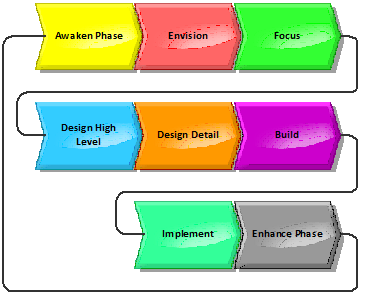BPI Build Phase - Storyline
The purpose of this phase is to construct and test all outputs of key components of the business solution. Subproject teams work in parallel to build an infrastructure capable of supporting the 'To-Be' processes. Information technology systems are validated against initial requirements both from a technical and a user perspective. All necessary support documentation is drafted or assembled in anticipation of the 'go-live' implementation date. Modifications/upgrades are made to physical facilities, and organizational programs are put in place to help deal with a broad range of employee-oriented issues.
In virtually all BPI programs, information technology (software, hardware, networks, etc.) is inevitably a critical component of the overall business solution. In this phase, the various aspects of the IT component are built from the conceptual designs that have previously been drafted. Custom Software Development is completed in those cases where software applications are created based on the functional requirements outlined in the Detailed Process Descriptions deliverable. When package or 'off-the-shelf' software has been selected to support the execution of business processes, it is necessary to perform Package Softwre Modifications for adequate support to occur. In either situation, various forms of Information Technology Testing will take place to ensure that the system is suitable for roll-out across the organization. This testing addresses both functional and technical aspects of the system.
Data Migration is an important part of this building process. It consists of identifying the data requirements of the new system and either manually keying-in data (from existing paper files) or developing conversion programs capable of uploading legacy-system data into the new computer system. The results of this deliverable are critical for all IT deliverables in this phase and for the Business Solution Roll-out deliverable in the next phase. Depending on urgency and necessity, data-conversion activities are often spread across months or even years.
During the building process, Implementation Pilots are executed to enable the company to assess within a controlled environment the look, feel and practicability of the processes, organizational changes and software/hardware being utilized. Pilot projects are commonly done, because they provide an opportunity to identify and remove as many problems as possible prior to implementation to the full organization.
New/Revised Policies outline the new rules for staff, and also explain 'why' the policy is being rewritten, as well as how their daily work routine will change as a result. Position/Competency Profiles outline key job responsibilities, and allocated time percentages are drafted in accordance with company practices. (Job description formats are often stipulated within provisions of collective agreements.)
A Measurement System is needed to set in place mechanisms that feed information to both staff and management pertaining to actual versus planned performance. The system that is developed must transcend simple process measurements and provide a true indication of the overall success of the BPI initiative (e.g. compliance with new policies, success of training programs, etc.). This system is complemented by the Performance Support and Recognition deliverable, which calls for development of compensation schemes, as well as performance management and reward processes. All of this is to help individuals and teams achieve agreed-upon business outcomes, and to provide appropriate recognition of their success.
Supporting documentation will invariably be required to provide the necessary support to employees upon full implementation of the business solution being built. Front-line employees refer to the Process/User's Manual for guidance on how to perform their new duties in redesigned processes, as well as how to perform day-to-day job tasks with the aid of the new IT system, if applicable. The Information Technology Operations Guide provides instructions to the company's information systems staff on how to perform support activities such as upgrade installation, database administration and backup / disaster recovery procedures.
Training support materials are built as part of the Learning Strategy and Materials deliverable and await delivery to employees in accordance with implementation schedules that are prepared later in this phase. New materials and educational software programs are tested with employee focus groups. In larger organizations, 'train the trainer' programs are also developed.
In those cases where significant changes in physical infrastructure need to be made to enable the business solution to be implemented, Facility Layout/Construction is aligned with the other process, IT and human resource activities that are occurring. Typically, external sub-contractors are hired to perform the work required. Hence, their progress must be closely monitored.
Once these components have been built, the final Acceptance Test is conducted. This test proves to the client that the business solution operates according to the functional requirements and officially marks its acceptance as satisfactory for installation and use by the employees. Implementation Plans are presented to management and users to outline the strategy and timing of the full-scale implementation of the business solution in the organization, including the sponsorship, commitment and communication activities to foster rapid acceptance. The Implementation Plans are used to mitigate risk and monitor progress of implementation as part of 'program management' (e.g. by scheduling ongoing feedback and status reporting to management, to avoid the potential for 'runaway' systems implementation problems).
By the end of the Build phase, the organization will have been shown a compelling demonstration of a working prototype of the business solution and will be able to confidently confirm the attainable benefits. Senior management will have declared 'We are ready to go live'. Detailed implementation activities of every sub-project will be known, and senior management will clearly comprehend their role during the upcoming Implement phase.
The Program Office monitors progress, risks and the quality of the multiple development sub-projects; coordinates the timing of implementation and organizational impacts; and establishes a mechanism for benefit-tracking.

